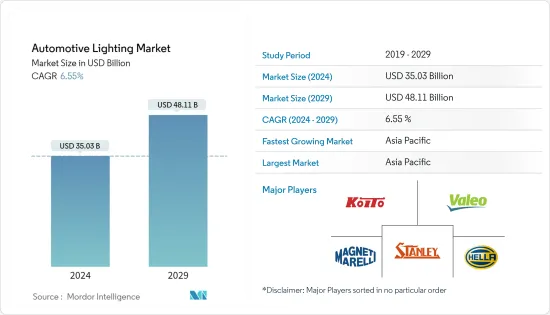
자동차용 조명(Automotive Lighting) 시장 규모는 2024년 350억 3,000만 달러로 추정되며, 2029년에는 481억 1,000만 달러에 이를 것으로 예측 되며, 예측 기간(2024-2029년)의 CAGR은 6.55%로 추이하며 성장 할 것으로 예상됩니다.

자동차와 SUV의 세계 판매 대수는 2017년 약 9,435만대를 피크로 감소하고, 2020년에는 7,700만대 미만으로 떨어졌습니다. 이 분야는 세계 경제의 감속과 모든 주요 경제국에서 COVID-19 팬데믹의 출현을 배경으로 감소 경향으로 변할 것으로 예측됩니다.
LED 라이트는 할로겐이나 HID 라이트에 비해 소비 전력이 적고 수명이 길기 때문에 자동차 제조업체는 LED 라이트를 자동차에 통합하는 데 큰 관심을 보이고 있습니다. 또한 LED 라이트는 내구성과 강도를 갖추고 있으며 고품질의 LED를 가지고 있으며 다른 모든 조명 기술보다 우수합니다.
자동차 제조업체는 새로운 조명 기술을 개발하고 헤드라이트와 같은 주요 조명 부품에 주력하고 있습니다. 시장 경쟁에서 우위를 차지하기 위해 파트너십을 맺고 있습니다. 헤드라이트는 야간 운전에 안전한 환경을 제공하는 주요 요인입니다. 예를 들어, Volkswagen은 Hella와 제휴하여 IQ.LIGHT LED 헤드 램프를 개발했습니다. 럭셔리 클래스의 신형 SUV 투아렉은 IQ.LIGHT-LED 매트릭스 헤드 램프와 256개의 LED를 채택하고 있습니다.
자동차 산업은 신기술과 전통적인 자동차 제조의 융합이라는 특징을 가진 기술 혁명의 한가운데에 있습니다. 전기 자동차 증가 추세에 따라 자동차 조명 제조업체는 기존의 오래된 조명을 대체하는 새로운 조명 기술을 개발하고 있습니다. 전기 자동차 제조업체는 최고의 차내 인테리어를 갖춘 새로운 차종을 출시합니다. 예를 들어, 2020년 9월, 루시드 모터스는 루시드의 독특한 공간 개념 철학을 기반으로 한 풀 사이즈의 럭셔리 클래스 인테리어를 제공하는 첨단스러운 전기 세단, 루시드 에어를 출시했습니다.
미래의 인테리어 조명 개발은 주로 안전, 커뮤니케이션, 편안함 및 스타일링 수요에 의해 추진됩니다. 빛 투영, 스마트 LED, 마이크로 LED, 스마트 기능면, 레이저 기반 조명, 온디맨드로 3D 광 패턴을 실현하는 가이드재, 숨겨진 조명 효과가 있는 영역 백라이트 등이 새로운 조명 기술의 일부입니다.
캐빈 라이트가 인기를 끌고 있습니다. 주로 독서등과 대시보드 라이트가 포함됩니다. 실내등은 독서등, 실내 환경 조명 시스템, 최적화된 도광 기술을 갖춘 지붕 모듈 등 다양한 용도가 있습니다. 또한 적응 조명 시스템은 LED 조명에 비해 수요가 적지 만 플러스 성장률을 보여줍니다.
지역적으로 자동차용 조명 시장은 아시아 태평양이 선도하고 있으며, 이어 유럽과 북미가 이어지고 있습니다. 이 지역 시장 성장을 가속하는 주요 요인은 다음과 같습니다.
유럽은 주요 지역으로 인식되고 있으며 탑승자와 보행자 모두의 안전에 초점을 맞추고 자동차 안전 기준을 시행하고 있습니다. 지역 자동차 제조업체와 자동차 부품 공급업체는 안전 기술 연구 개발에 지속적으로 투자하고 있습니다. 자동차 산업의 급속한 기술 발전에 따라 유럽은 세계 자동차 조명 시장에서 주요 역할을 수행할 것으로 예상됩니다. 이 지역에는 Hella KGaA Hueck&Co., Philips, OSRAM Licht AG, Valeo, Zizala, Robert Bosch, ZKW 등 수많은 선도적인 제조업체가 있습니다.
자동차용 조명 시장은 Koito Manufacturing, Valeo Group, Magneti Marelli, Stanley Electric, Hella, Lumax Industries, Zizila Lichtsysteme, Osram, Tungsram 등 주요 기업에 의해 상당히 통합되어 있습니다. 각 회사는 합작 투자에 진출하여 세계의 존재를 확대하고 있습니다.
The Automotive Lighting Market size is estimated at USD 35.03 billion in 2024, and is expected to reach USD 48.11 billion by 2029, growing at a CAGR of 6.55% during the forecast period (2024-2029).

Global sales of cars and SUVs fell to just under 77 million units in 2020, down from a peak of almost 94.35 million units in 2017. The sector is projected to experience a downward trend on the back of a slowing global economy and the advent of the coronavirus pandemic in all key economies.
Vehicle manufacturers are showing great interest in integrating LED lights in vehicles, as these lights consume less power and have a longer life when compared to halogen and HID lights. Furthermore, LED lights offer durability and strength, have high-quality light-emitting diodes, and are superior to all other forms of lighting technology.
The automotive manufacturers are developing new lighting technologies and are focusing on the major lighting components, such as headlights. They are entering into partnerships to be ahead in the competition within the market. Headlights are a major factor in providing a safe environment for driving at night. For instance, Volkswagen partnered with Hella to develop IQ.LIGHT LED headlamps. The new luxury-class Touareg SUV uses the IQ.LIGHT-LED Matrix Headlamps and 256 LEDs.
The automotive industry is in the midst of a technological revolution characterized by the convergence of new technology with traditional car manufacturing. With the increasing trend of electric vehicles, automotive lighting manufacturers are developing new lighting technologies to replace the old traditional lights. Electric vehicle manufacturers are launching new vehicle models with the best cabin interiors. For instance, in September 2020, Lucid Motors launched Lucid Air, a luxurious electric sedan that offers a full-size luxury-class interior, which is based on Lucid's exclusive Space Concept philosophy.
Upcoming interior lighting developments will be mainly driven by safety, communication, comfort, and styling demands. Light projections, smart LEDs, micro-LEDs, smart functional surfaces, laser-based lighting, guiding materials for 3D light patterns on-demand, and area backlighting with hidden-until-lit effects are some of the new lighting technologies.
Cabin lights are gaining popularity. They mainly include reading lights and dashboard lights. Interior lights include various applications in the form of reading lamps, ambient interior lighting systems, and roof modules with optimized light guide technology. Additionally, the adaptive lighting system is seeing a positive growth rate, although their demands remain much smaller than LED lights.
Geographically, the automotive lighting market is led by the Asia-Pacific region, followed by the European and North American regions. Some of the major factors driving the growth of the markets in these regions are -
Europe has been recognized as a major region, focusing on both passengers and pedestrian safety and implementing safety standards for vehicles. The regional automotive manufacturers and the automotive component suppliers have been continually investing in the R&D of safety technologies. With rapid technological advancements in the automotive industry, the European region is expected to play a major role in the global automotive lighting market. The region is home to numerous major manufacturers, such as Hella KGaA Hueck & Co., Philips, OSRAM Licht AG, Valeo, Zizala, Robert Bosch, and ZKW.
The automotive lighting market is fairly consolidated with key players such as Koito Manufacturing, Valeo Group, Magneti Marelli, Stanley Electric, Hella, Lumax Industries, Zizila Lichtsysteme, Osram, and Tungsram. Companies are entering into joint ventures and are expanding their global presence. For instance,